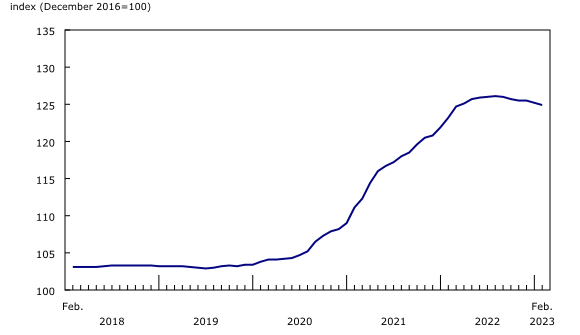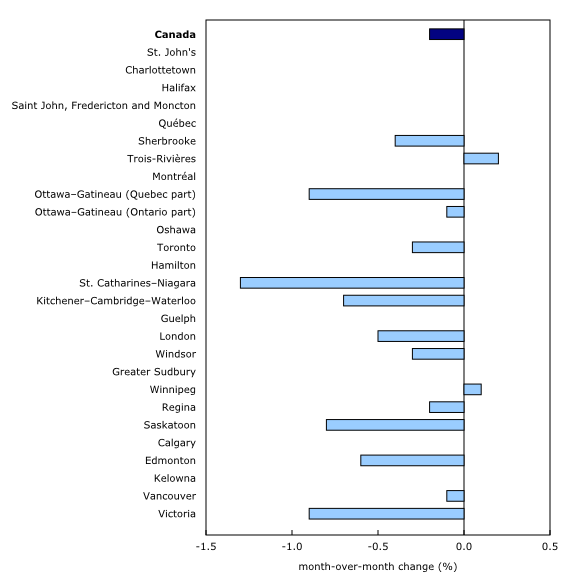OTTAWA
,
March 22, 2023
(press release)
–
New home prices in Canada continue declining in February Chart 1: New Housing Price Index Elevated borrowing costs continue contributing to the decline in new house prices High mortgage rates continued slowing housing demand, with the Canada Mortgage and Housing Corporation reporting 44.1% more unsold, newly constructed single-family homes in Canada in February 2023 compared with February 2022. Similar conditions were seen in the resale housing market, with the number of national sales decreasing 40.0% year over year in February 2023, as reported by the Canadian Real Estate Association. In February, prices were also down in Toronto (-0.3%) and Vancouver (-0.1%), the two largest housing markets in Canada, and thus largely contributing to the decline of the national index. Prices for new homes increased in Trois-Rivières (+0.2%) and Winnipeg (+0.1%) in February. Chart 2: New house prices decline at the national level Canada's most expensive housing markets see muted annual price changes According to the Canadian Home Builders' Association, builder confidence declined over the previous year, with its single-family Housing Market Index declining 58.7 points in the fourth quarter of 2022 (26.2) compared with the fourth quarter of 2021 (84.9). The report links the decline to the uncertainty in the housing market, amid high interest rates. In Canada's most expensive markets, which include the Greater Golden Horseshoe (Oshawa, Toronto, Hamilton, St. Catharines–Niagara, Kitchener–Cambridge–Waterloo and Guelph), Vancouver and Victoria, new home price changes were muted year over year, ranging from -1.1% to +0.3%. In contrast, comparatively less expensive housing markets in Canada, particularly Calgary (+6.8%), Windsor (+4.9%) and Ottawa (+4.5%), posted the largest annual price increases among the cities surveyed. These increases have also moderated compared with February 2022, when annual growth stood at 18.7% in Calgary, 20.7% in Windsor and 20.2% in Ottawa. Note to readers The prices collected from builders and included in the index are market selling prices less value-added taxes, such as the federal goods and services tax and the provincial harmonized sales tax. The survey covers the following dwelling types: new single homes, semi-detached homes and townhomes (row or garden homes). The index is available at the national and provincial levels and for 27 census metropolitan areas (CMAs). The index is not subject to revision and is not seasonally adjusted. Products The New Housing Price Index: Interactive Dashboard, which allows users to visualize statistics on new housing prices, is available. The Housing Market Indicators dashboard, which provides access to key housing market indicators for Canada, by province and by CMA, is also available. For more information on the topic of housing, visit the Housing statistics portal. The video "Producer price indexes" is available on the Statistics Canada Training Institute web page. It introduces Statistics Canada's producer price indexes—what they are, how they are compiled, and what they are used for. Statistics Canada launched the Producer Price Indexes Portal as part of a suite of portals for prices and price indexes. It provides users with a single point of access to a wide variety of statistics and measures related to producer prices. Next release Contact information Industry Intelligence Editor's Note: This press release omits select charts and/or marketing language for editorial clarity. Click here to view the full report.
The national index declined 0.2% month over month in February, following a similar decrease in January. The index has been down in five of the last six months. In February, prices were down or unchanged in 25 of the 27 census metropolitan areas surveyed and up in 2.
In February, new home prices fell the most in St. Catharines–Niagara (-1.3%), Victoria (-0.9%) and Gatineau (-0.9%), with builders noting deteriorating market conditions as the reasons for the declines.
Nationally, new house prices increased 1.4% on a year-over-year basis, which is significantly lower than the annual change of 10.9% recorded in February 2022, when the Bank of Canada policy interest rate was still at its all-time low of 0.25%, compared with the current rate of 4.5%. As well, lumber prices, which put upward pressure on construction costs one year ago, fell 52.5% year-over-year in February 2023.
The New Housing Price Index (NHPI) measures changes over time in the selling prices of new residential houses. The prices are those agreed upon between the contractor and the buyer at the time the contract is signed. The detailed specifications for each new house remain the same between two consecutive periods.
The Technical Guide for the New Housing Price Index (NHPI) is available. This document provides details on the methodology used to calculate the NHPI.
The New Housing Price Index for March will be released on April 24.
For more information, or to enquire about the concepts, methods or data quality of this release, contact us (toll-free 1-800-263-1136; 514-283-8300; infostats@statcan.gc.ca) or Media Relations (statcan.mediahotline-ligneinfomedias.statcan@statcan.gc.ca).
* All content is copyrighted by Industry Intelligence, or the original respective author or source. You may not recirculate, redistrubte or publish the analysis and presentation included in the service without Industry Intelligence's prior written consent. Please review our terms of use.




